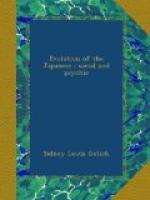That this love of country, even this conception of country, is a modern thing will appear from two further facts. Until modern times there was no such thing as a national flag. The flaming Sun on a field of white came into existence as a national flag only in 1859. The use of the Sun as the symbol for the Emperor has been in vogue since 700 A.D., the custom having been adopted from China. “When in 1859 a national flag corresponding to those of Europe became necessary, the Sun Banner naturally stepped into the vacant place."[A]
The second fact is the recent origin of the festival known as “Kigensetsu.” It occurs on February 11 and celebrates the alleged accession of Jimmu Tenno, the first Emperor of Japan, to the throne 2560 years ago (660 B.C.). The festival itself, however, was instituted by Imperial decree ten years ago (1890).
The transformation which has come over Japan in a single generation requires interpretation. Is the change real or superficial? Is the new social order “a borrowed trumpery garment, which will soon be rent by violent revolutions,” according to the eminent student of racial psychology, Professor Le Bon, or is it of “a solid nature” according to the firm belief of Mr. Stanford Ransome, one of the latest writers on Japan?
This is the problem that will engage our attention more or less directly throughout this work. We shall give our chief thought to the nature and development of Japanese racial characteristics, believing that this alone gives the light needed for the solution of the problem.[B]
III
THE PROBLEM OF PROGRESS
What constitutes progress? And what is the true criterion for its measurement? In adopting Western methods of life and thought, is Japan advancing or receding? The simplicity of the life of the common people, their freedom from fashions that fetter the Occidental, their independence of furniture in their homes, their few wants and fewer necessities—these, when contrasted with the endless needs and demands of an Occidental, are accepted by some as evidences of a higher stage of civilization than prevails in the West.
The hedonistic criterion of progress is the one most commonly adopted in considering the question as to whether Japan is the gainer or the loser by her rapid abandonment of old ways and ideas and by her equally rapid adoption of Western ones in their place. Yet this appeal to happiness seems to me a misleading because vague, if not altogether false, standard of progress. Those who use it insist that the people of Japan are losing their former happiness under the stress of new conditions. Now there can be no doubt that during the “Kyu-han jidai,” the times before the coming in of Western waves of life, the farmers were a simple, unsophisticated people; living from month to month with little thought or anxiety. They may be said to have been happy.




